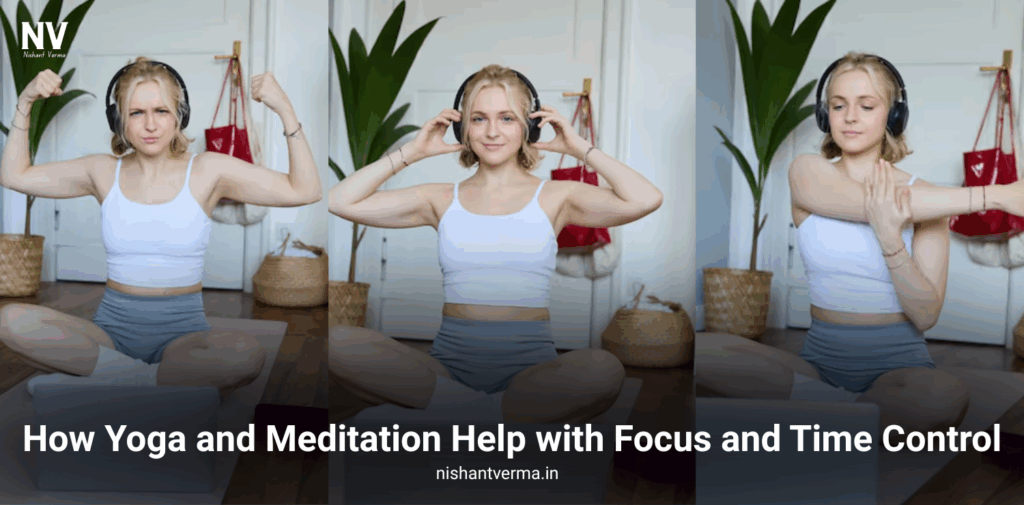In today’s fast-paced world, where everyone is running behind deadlines and multitasking has become the new normal, staying focused and managing time effectively has become a real challenge. Especially for students, working professionals, and even homemakers, the pressure of balancing multiple responsibilities can lead to stress, confusion, and a lack of concentration. But ancient Indian practices like Yoga and Meditation offer a simple yet powerful solution.
Yoga and Meditation have been a part of Indian culture for thousands of years. These are not just physical exercises or spiritual rituals, but complete practices that improve our mental clarity, focus, and help us live a more disciplined life. This article will help you understand how Yoga and Meditation can support better focus and time control, especially suited for an Indian audience, and how you can start your journey easily.
Understanding the Connection Between Mind, Focus, and Time
Our mind is like a monkey — always jumping from one thought to another. In a single moment, we think about what to cook for dinner, the next day’s meeting, an old memory, or even something completely random. This mental chatter is one of the biggest reasons for lack of focus.
Focus means giving our full attention to one task or thought at a time. When we are truly focused, we finish our work faster and with better quality. This directly affects how we manage our time.
Now, the problem is not that we don’t have enough time, but that we don’t manage our energy and attention well. This is where Yoga and Meditation come in. These practices calm the mind, reduce stress, and increase awareness. They help us live in the present moment instead of getting lost in past regrets or future worries.

How Yoga Improves Focus and Mental Clarity
Yoga is much more than just bending and stretching the body. It is about creating a balance between body and mind. When we do Yoga asanas (postures) along with proper breathing techniques (pranayama), our mind becomes calm and alert.
Certain Yoga postures directly help improve focus and brain function. For example:
- Tadasana (Mountain Pose) helps with posture and body awareness
- Vrikshasana (Tree Pose) improves balance and concentration
- Padmasana (Lotus Pose) provides a stable base for meditation
- Paschimottanasana (Seated Forward Bend) relaxes the nervous system
Also, when we practice slow and mindful Yoga, our breathing becomes deep and regular. This improves oxygen supply to the brain, which helps in increasing alertness and mental clarity.
Yoga also improves sleep quality and reduces mental fatigue, which are both important for maintaining long-term focus.
Meditation: The Art of Training Your Mind
Meditation is the practice of sitting quietly and observing your thoughts without judgment. At first, it may feel difficult because our mind is used to running wild. But with regular practice, you will start to feel the difference.
Meditation helps in the following ways:
- Reduces stress and anxiety
- Increases self-awareness
- Trains the brain to stay in the present moment
- Improves patience and emotional control
There are many types of meditation, but for beginners, Anapanasati (Mindfulness of Breathing) and Mantra Meditation are very effective. Chanting “Om” or “So Hum” while focusing on the breath can bring immediate calmness.
For Indian audiences, practices like Gayatri Mantra chanting or meditating on a Deity (like Shiva or Krishna) can be deeply grounding and bring spiritual focus along with mental clarity.
Time Management Through a Yogic Lifestyle
Time control is not just about having a planner or setting alarms. It is about how disciplined and aware you are throughout the day. A yogic lifestyle promotes discipline (Yama and Niyama), early rising, clean habits, and a balanced routine.
Waking up early in Brahma Muhurat (about 1.5 hours before sunrise) is highly recommended in yogic texts. This time is calm, pure, and ideal for Yoga and Meditation. When you start your day with such clarity, your whole day becomes more organized.
By practicing Yoga and Meditation daily, you become more aware of how you spend your time. You start to notice time-wasting habits like over-scrolling on your phone, overthinking, or unnecessary talking. Slowly, you begin to take charge of your time instead of letting the day control you.

Scientific Support Behind Yoga and Meditation
Modern research has confirmed what ancient yogis always knew. Many studies from Indian and international universities show that people who practice Yoga and Meditation regularly have better memory, decision-making ability, and time management skills.
One study conducted by the All India Institute of Medical Sciences (AIIMS) found that meditation increases the thickness of the prefrontal cortex — the part of the brain responsible for planning, focus, and judgment. Another study showed that Yoga reduces cortisol levels (the stress hormone), which helps in staying calm even during pressure.
This shows that these practices are not just spiritual or philosophical, but are also backed by modern science.

How to Start Your Journey: Simple Tips for Beginners
If you’re new to Yoga and Meditation, here are some simple steps to get started:
- Start with just 10 minutes a day in the morning
- Choose a clean and quiet place to sit
- Begin with simple breathing exercises like Anulom Vilom or Bhramari
- Learn 3-4 basic asanas from a certified Yoga teacher or online class
- Be consistent, even if you do a little every day
- Avoid distractions during practice (keep phone on silent, etc.)
- Keep a small diary to write how you feel after practice
You can also use simple tools like bhajans, devotional songs, incense sticks, or a small idol or candle to create a peaceful atmosphere.
Slowly, as you feel the benefits, you’ll automatically want to go deeper into the practice.
Conclusion: A Powerful Ancient Key to Modern Problems
In a world where stress, distraction, and time pressure have become normal, Yoga and Meditation offer a timeless and powerful solution. These practices are not only rooted in Indian tradition but are also easy to start and maintain.
They help improve focus, control time better, and live a more balanced life — mentally, physically, and spiritually. The best part is, anyone can start — whether you’re a busy college student, a working parent, or a retired senior citizen.
So why not take 10 minutes out of your day for your mind, just like you do for your body or work? You don’t need any fancy equipment or a special place. All you need is a little willingness and regularity.
Remember, Yoga and Meditation are not just practices — they are lifestyles that can transform your entire way of living. Start today, and see how time begins to work for you, not against you.
If you found this article helpful, consider trying a few simple Yoga poses or meditation exercises this week. You may be surprised by how much calmer, clearer, and more focused you feel — not just in work, but in life itself.




